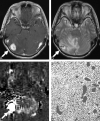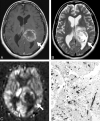Perfusion imaging of brain tumors using arterial spin-labeling: correlation with histopathologic vascular density
- PMID: 18184842
- PMCID: PMC7978189
- DOI: 10.3174/ajnr.A0903
Perfusion imaging of brain tumors using arterial spin-labeling: correlation with histopathologic vascular density
Abstract
Background and purpose: We investigated the relationship between tumor blood-flow measurement based on perfusion imaging by arterial spin-labeling (ASL-PI) and histopathologic findings in brain tumors.
Materials and methods: We used ASL-PI to examine 35 patients with brain tumors, including 11 gliomas, 9 meningiomas, 9 schwannomas, 1 diffuse large B-cell lymphoma, 4 hemangioblastomas, and 1 metastatic brain tumor. As an index of tumor perfusion, the relative signal intensity (SI) of each tumor (%Signal intensity) was determined as a percentage of the maximal SI within the tumor per averaged SI within normal cerebral gray matter on ASL-PI. Relative vascular attenuation (%Vessel) was determined as the total microvessel area per the entire tissue area on CD-34-immunostained histopathologic specimens. MIB1 indices of gliomas were also calculated. The differences in %Signal intensity among different histopathologic types and between high- and low-grade gliomas were compared. In addition, the correlations between %Signal intensity and %Vessel or MIB1 index were evaluated in gliomas.
Results: Statistically significant differences in %Signal intensity were observed between hemangioblastomas versus gliomas (P < .005), meningiomas (P < .05), and schwannomas (P < .005). Among gliomas, %Signal intensity was significantly higher for high-grade than for low-grade tumors (P < .05). Correlation analyses revealed significant positive correlations between %Signal intensity and %Vessel in 35 patients, including all 6 histopathologic types (rs = 0.782, P < .00005) and in gliomas (rs = 0.773, P < .05). In addition, in gliomas, %Signal intensity and MIB1 index were significantly positively correlated (rs = 0.700, P < .05).
Conclusion: ASL-PI may predict histopathologic vascular densities of brain tumors and may be useful in distinguishing between high- and low-grade gliomas and in differentiating hemangioblastomas from other brain tumors.
Figures






Similar articles
-
Assesment of perfusion in glial tumors with arterial spin labeling; comparison with dynamic susceptibility contrast method.Eur J Radiol. 2014 Oct;83(10):1914-9. doi: 10.1016/j.ejrad.2014.07.002. Epub 2014 Jul 15. Eur J Radiol. 2014. PMID: 25087109
-
[Application value of whole brain 3D artery spin labeling in diagnosis of intracranial tumors].Zhonghua Yi Xue Za Zhi. 2017 Jun 20;97(23):1801-1804. doi: 10.3760/cma.j.issn.0376-2491.2017.23.009. Zhonghua Yi Xue Za Zhi. 2017. PMID: 28648002 Chinese.
-
[Grading of adults primitive glial neoplasms using arterial spin-labeled perfusion MR imaging].J Neuroradiol. 2011 Oct;38(4):207-13. doi: 10.1016/j.neurad.2010.12.003. Epub 2011 Feb 25. J Neuroradiol. 2011. PMID: 21353707 French.
-
A meta-analysis of arterial spin labelling perfusion values for the prediction of glioma grade.Clin Radiol. 2017 Mar;72(3):255-261. doi: 10.1016/j.crad.2016.10.016. Epub 2016 Dec 6. Clin Radiol. 2017. PMID: 27932251 Review.
-
Arterial spin labeling clinical applications for brain tumors and tumor treatment complications: A comprehensive case-based review.Neuroradiol J. 2023 Apr;36(2):129-141. doi: 10.1177/19714009221114444. Epub 2022 Jul 10. Neuroradiol J. 2023. PMID: 35815750 Free PMC article. Review.
Cited by
-
Radiomics in Kidney Cancer: MR Imaging.Magn Reson Imaging Clin N Am. 2019 Feb;27(1):1-13. doi: 10.1016/j.mric.2018.08.005. Magn Reson Imaging Clin N Am. 2019. PMID: 30466904 Free PMC article. Review.
-
Arterial spin labeling of hemangioblastoma: differentiation from metastatic brain tumors based on quantitative blood flow measurement.Neuroradiology. 2012 Aug;54(8):809-13. doi: 10.1007/s00234-011-0977-5. Epub 2011 Nov 10. Neuroradiology. 2012. PMID: 22068625
-
Dynamic glucose enhanced (DGE) MRI for combined imaging of blood-brain barrier break down and increased blood volume in brain cancer.Magn Reson Med. 2015 Dec;74(6):1556-63. doi: 10.1002/mrm.25995. Epub 2015 Sep 25. Magn Reson Med. 2015. PMID: 26404120 Free PMC article.
-
Differentiation of Glioblastoma from Brain Metastasis: Qualitative and Quantitative Analysis Using Arterial Spin Labeling MR Imaging.PLoS One. 2016 Nov 18;11(11):e0166662. doi: 10.1371/journal.pone.0166662. eCollection 2016. PLoS One. 2016. PMID: 27861605 Free PMC article.
-
Differentiating Glioblastomas from Solitary Brain Metastases: An Update on the Current Literature of Advanced Imaging Modalities.Cancers (Basel). 2021 Jun 13;13(12):2960. doi: 10.3390/cancers13122960. Cancers (Basel). 2021. PMID: 34199151 Free PMC article. Review.
References
-
- Chalela JA, Alsop DC, Gonzalez-Atavales JB, et al. Magnetic resonance perfusion imaging in acute ischemic stroke using continuous arterial spin labeling. Stroke 2000;31:680–87 - PubMed
-
- Kimura H, Kado H, Koshimoto Y, et al. Multislice continuous arterial spin-labeled perfusion MRI in patients with chronic occlusive cerebrovascular disease: a correlative study with CO2 PET validation. J Magn Reson Imaging 2005;22:189–98 - PubMed
-
- Detre JA, Alsop DC, Vives LR, et al. Noninvasive MRI evaluation of cerebral blood flow in cerebrovascular disease. Neurology 1998;50:633–41 - PubMed
-
- Alsop DC, Detre JA, Grossman M. Assessment of cerebral blood flow in Alzheimer's disease by spin-labeled magnetic resonance imaging. Ann Neurol 2000;47:93–100 - PubMed
Publication types
MeSH terms
Substances
LinkOut - more resources
Full Text Sources
Other Literature Sources
Medical
Research Materials
Miscellaneous
